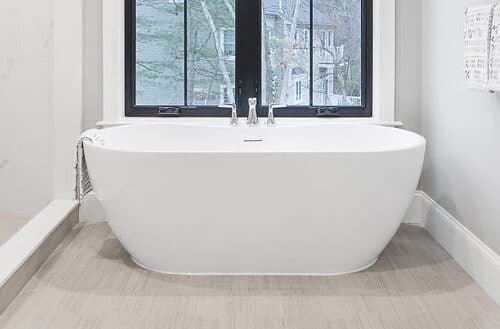While you’re lying there soaking and your mind gets to wandering, one of the thoughts that might pass through your head is “where does the water go?”. The answer is surprisingly interesting! Finding out how a bathtub drain works can help you with blockages and gives you insights into the anatomy of your home. So, how does a bathtub drain work?
Basic Components of A Bathtub Drain
Far from simply being a hole which water falls through, there’s a surprising amount of engineering and thought which goes into your bathtub plumbing. The basic anatomy of a tub drain goes something like this:
- Drain Pipe: Connected to your plughole, this pipe caries the water away from your tub when you pull the plug.
- Overflow Pipe: Connected to the drain pipe at one end and a hole further up your tub at the other, this works to help avoid flooding through overfilling your bath.
- Drain Stopper: The plug. They come in various configurations ranging from a rubber stopper to a mechanical plunger. There are various ways of operating them too:
- Plunger
- Pop-up
- Lift-and-turn
- Flip-it
- Toe-touch
- The P-trap: A P-trap is connected to the drain pipe. It holds a certain level of water and uses this to stop sewer gasses from rising into your home through the drain.
Good old fashioned rubber stoppers
The Mechanics of A Bathtub Drain
All of these elements work in concert to ensure that water gets from your tub and down the drain pipe where it can be conducted safely away. There are two major forces at play here:
Flow dynamics:
There are some surprisingly interesting physics going on in your tub. The principle of energy conversion says that the water in your tub is full of potential energy. When the plug is pulled, this is converted to kinetic energy as the water flows.
The rate at which this happens is governed by Torricelli’s Law which states that the velocity of efflux of a fluid through a hole under the force of gravity is proportional to the square root of the vertical distance between the fluid surface and the center of the hole.
Put simply, this means the higher the level of water in your tub, the faster it flows. The same effect goes on within the drain pipe and allows the water to flow through the sewers to the treatment plant.
Gravity:
The drain sits on the bottom of your bathtub, harnessing gravity to pull water downwards. As gravity exerts itself against the water, it’s pulled down towards the center of the earth. When the drain is closed, the bottom of the tub is in effect ‘the ground’. When it’s open, the drain-pipe becomes the new ‘ground’.
Other factors in play include venting which stops build-ups of gas from forming in your plumbing and mean that your bathtub drain isn’t competing against vacuums forming in the pipes.
Common Problems and Diagnostics
If you’re reading this after searching something like “how does a bathtub drain work” there’s a better than even chance it wasn’t mere curiosity that led you here. Despite being a fairly simple system, things can, and frequently do, go wrong.
Here are a few of the most common problems, what causes them and, most helpfully, how to sort them out:
Clogs
Perhaps the most common problem that people are facing when they find themselves questioning “how does a bathtub drain work” is the simple clog.
As we wash, loose hair is dislodged and finds its way into the drain. When combined with the soap scum produced from our hygiene problems, the result is a sticky, gunky clog that lodges itself in the drain, restricting or even blocking flow.
The Solution
Put simply: remove the clog.
Sometimes it’s relatively easy- simply scoop up the matted hair and soap from around your bathtub drain and dispose of it in the trash. Sometimes, however, the clog is located further along the drain-pipe and you’ll require a drain snake to fish it out.
You should generally avoid chemical clog clearers unless it’s a really bad example. They contain some pretty noxious chemicals and repeated use is bad for both your health and plumbing.
Slow Draining
Again, the most likely culprit here is a clog partially blocking your drain, but there are other potential causes of a slow draining tub.
If it doesn’t seem to be caused by a clog, there’s a good chance that you’re facing a vacuum trap. This means that air and gases have become trapped somewhere in the system and are stopping water flowing properly. This might be a problem with your venting or P-trap. If you hear a ‘gurgling’ sound when you pull the plug, chances are that this is what’s going on.
The Solution
The first option is to try plunging your system or washing out your drain with a hose. If these don’t sort it, whether it’s the venting system or P-trap is to blame, it’s probably a matter for a qualified professional. Access to your drainage is probably fairly tricky and might involve climbing on the roof.
Leaks
Of course, water being slow to move isn’t the only potential problem- sometimes it moves where you don’t want it. If you’re finding water outside of the tub, you’ve probably got a leak somewhere.
The most likely place that you’ll find these is around joints and connections in your drain. Common places include:
- Seals: The part which sits in the tub usually uses pressure to hold a rubber or silicone seal in place. Over time, exposure to soap and general wear and tear will cause this to perish, making them ineffective.
- Connections: most baths use compression fittings where a plastic ring is tightened to squeeze a seal against another pipe. Sometimes these come loose or the rubber can become damaged.
- Joints: another common method of connecting pipes in a waste system uses solvent welding. If the pipes take a knock, this can damage the joints, letting water out.
The Solution
Once you’ve identified the place where water is escaping from your drain, it should be a simple matter to replace that part like-for-like. If you’re unsure, a plumber is only ever a phone call away.
How to Maintain Your Bathtub Drain
Like any system in your home, your bathtub drain needs maintenance. Luckily keeping your bathtub plumbing in good working order is fairly easy and can be worked into your general house-keeping without much fuss.
Regular Cleaning
Preventing clogs in the first place is, without a doubt, the easiest way of dealing with them. Make sure that you fish any loose hairs out of the drain after any shower or bath and allow the hot water to run to break up any soap scum after every use.
Make Natural Cleaners
The harsh chemicals in the cleaners you can buy from the store are expensive and harsh. They’re also not great for you or your plumbing and it’s best to avoid them when possible. Luckily, you can make an effective cleaner with baking soda and vinegar.
- Pour baking soda into your drain
- Pour vinegar into it too
- Watch as the bubbles do their thing
- Rinse with warm water.
Not only will this leave your drain smelling great, it will break up any minor-to-moderate clogs which might be forming. Vinegar and baking soda are a magic combination and not just great for science-fare volcanos!
Drain Discipline
It can be tempting to think of drains as magic holes which make liquids disappear but not everything should be poured down there. Keep your bathtub drain for bath and shower water and make sure you flush it out by running the hot water after every use to break up anything which may be sticking there.
DIY Repairs
Of course, even with the best drain discipline and cleaning routine, things will go wrong. Luckily there are a lot of things you can do yourself to get water flowing away again.
Clearing clogs
Depending on where and how serious the clog is, there are a few things you can do:
- Clear the drain cover
- Use a drain snake
- Plunge your drain
- Make a de-clogger with vinegar and baking soda
If none of these sort your issue, contact a plumber.
Replacing Your Stopper
The stopper does exactly what you think it does- it stops water from entering the drain. There are lots of models out there, but the most common types screw in and out of the top of your P-trap. The exact method will depend on your particular model, but if you can get access under your bath, it should be fairly straight-forward to replace like for like.
Check for Leaks
Checking for leaks is a straightforward process: follow the pipe along until you find the source. Depending on where the leak is, it might be as simple as tightening a joint or it may involve replacing a seal- either way, if you can get access easily, it’s a fairly straightforward process.
When To Call A Professional Plumber
While there’s a lot you can do for yourself, sometimes it’s best to get the pros in.
If an issue develops that seems more complex or harder to access, the experience (and specialist tools) of a professional plumber may well be the solution. Things like deep clogs, major leaks or problems with venting are usually best left to those who know what they’re doing!
A qualified plumber will be able to diagnose, rectify and, best of all, guarantee their work. The peace of mind is worth the fee.

